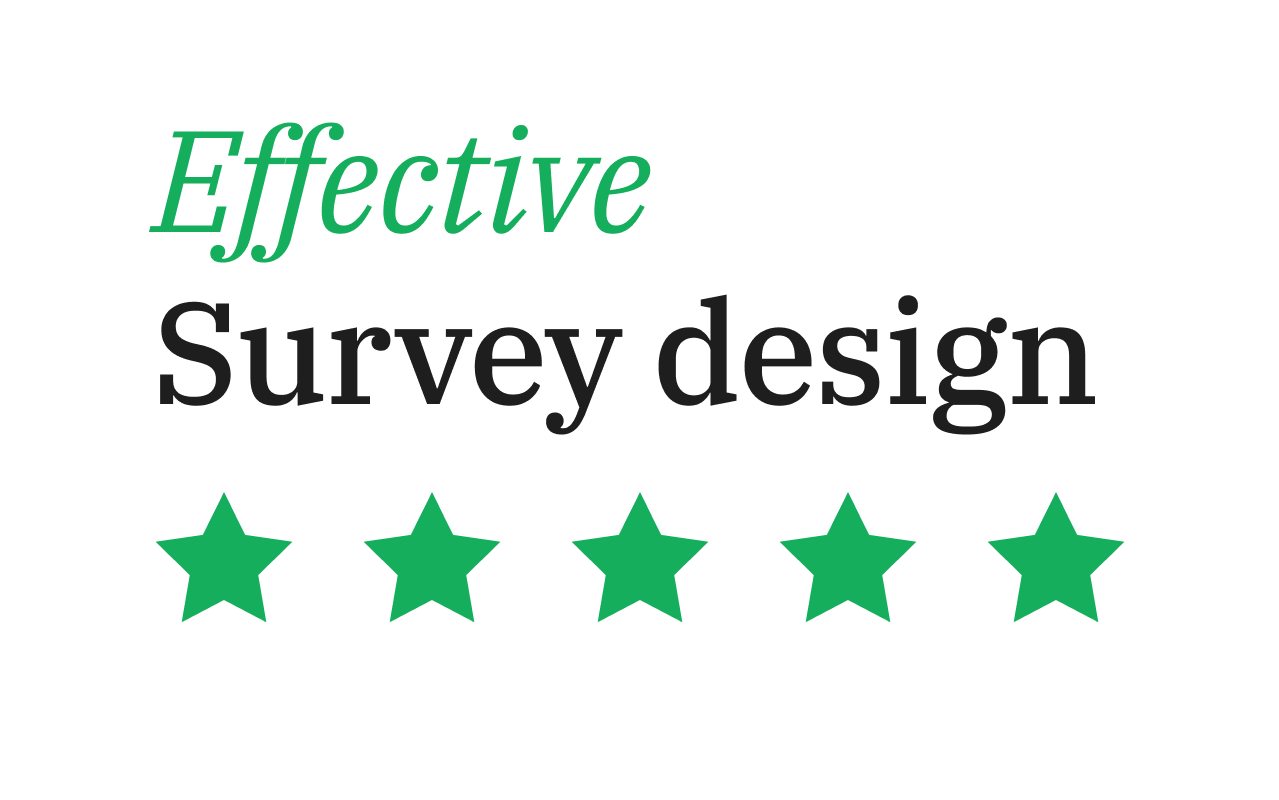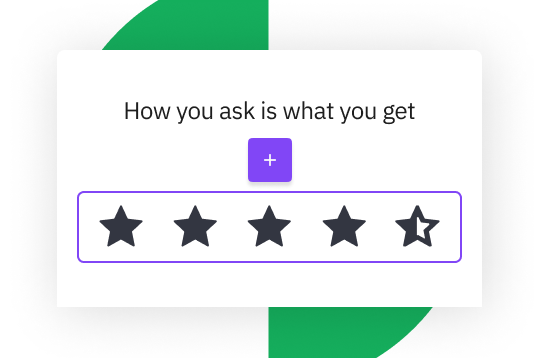In a world that is increasingly data-driven, harnessing the power of feedback through online surveys has become critical ...
In a world that is increasingly data-driven, harnessing the power of feedback through online surveys has become critical for businesses, educational institutions, government agencies, and even private users. And the right survey software is what makes this possible.
What online survey administration software is best for you?
The answer to this question depends largely on who you are and what your specific needs entail. Let's break it down and take a deeper look on the various types of users and the considerations you should keep in mind:
Enterprise survey software
For large corporations and multi-national enterprises, the demands on survey software are quite extensive. These organizations require a comprehensive, robust survey platform that can handle a significant volume of data and complex structures without compromising speed or performance. The software should offer advanced data analysis tools, enabling organizations to dig deep into their data, recognize patterns, and make informed decisions. Additionally, it's crucial for the software to offer extensive customization, allowing the survey to seamlessly align with the company's branding and to fit into a range of different scenarios. In such settings, integration capability is also a key factor. The software needs to easily sync with other business systems such as CRM and ERP systems for smooth, cross-functional operations. Finally, as enterprises often operate on a global scale, multilingual support is a vital component to ensure inclusivity and reach.
Survey software for small businesses
In the realm of small businesses, the needs are somewhat different. These operations require software that provides a balance between being feature-rich and cost-effective. The survey tools they choose need to be intuitive and user-friendly, simplifying the process of creating, distributing, and analyzing surveys. Small businesses often operate with lean teams, so a tool that requires minimal training to use and manage is crucial. While affordability is key, this doesn't mean they should compromise on features. Essential components include customizable templates, varied question types, and basic data analysis tools. More so, small businesses can greatly benefit from survey software that provides easy ways to share surveys on social media and via email campaigns, broadening their reach without extensive marketing budgets.
Survey software for universities and students
Universities, research institutions, and students have unique needs when it comes to survey software. Academic research often involves complex question structures and a need for diverse question types, including open-ended, multiple-choice, Likert scales, and more. The software should have strong data analysis capabilities, allowing researchers to extract meaningful insights from their data. Multilingual support is another essential feature given the international environment of most academic institutions.Additionally, many institutions are bound by strict data privacy rules, so a tool that complies with data privacy regulations, like GDPR, is non-negotiable. Considering budget constraints that students and educators often face, affordability and the availability of special academic pricing or programs is also a desirable attribute.
Survey software for government
Government agencies require survey software that is not only robust and reliable but also highly secure. These agencies often deal with sensitive data on a large scale, so top-notch security measures are critical. The survey tool needs to comply with numerous regulations, including accessibility standards to ensure all citizens can participate. Given the large-scale nature of many government surveys, the software must be capable of handling high volumes of responses without any issues. Furthermore, it's important that the software provides advanced analysis features to make sense of large data sets and enable informed policy-making.
Survey software for private users
For individual or personal users, the requirements for survey software tend to lean towards simplicity and ease of use. Whether they are conducting a survey for a personal project, a community initiative, or creating fun quizzes for friends and family, the software needs to be straightforward and intuitive. Basic customization options are a plus for personal users, allowing them to add a personal touch to their surveys.Given that most personal users don't require advanced analytics, simple reporting, and data visualization tools should suffice. And of course, as private users often work with limited resources, the software needs to be affordable or even free.
What features must modern survey software analysis software have?
To be truly effective in today's fast-paced, digital world, survey software must possess a robust set of features:
A variety of question types: Modern survey software should offer a wide array of question types, allowing users to collect feedback in the most effective way. This could range from simple multiple-choice questions, open-ended text responses, and drop-down lists to more complex grid or matrix-style questions. The variety in question types allows for a more comprehensive and nuanced collection of data.
Data analysis capabilities: The primary purpose of conducting a survey is to gain insights from the collected data. This makes the ability to analyze data directly within the software or export it for further analysis in other statistical tools a must-have feature. Ideally, the software should provide easy-to-understand reporting options, data visualization tools like graphs and charts, and advanced statistical analysis for more complex surveys.
Customization: Each survey is unique and serves a specific purpose. Therefore, the software should provide ample customization options to tailor the survey to its intended audience and objectives. This could include customization of survey appearance and design, question logic, and even the language of the survey.
Multilingual support: As we live in an increasingly global world, the capacity for a survey tool to support multiple languages is crucial. This is not only important for multinational businesses but also for research institutions, governments, and organizations wanting to reach a broader audience. The software should allow for multilingual survey creation, administration, and analysis.
Security: With data breaches becoming increasingly common, robust security measures are a non-negotiable feature of any online tool, including survey software. This includes secure data storage and transfer, access controls, data encryption, and compliance with data privacy regulations such as GDPR.
Scalability: Scalability is a crucial feature that ensures the software can adapt to growing or varying demands. Whether you're a small business looking to grow or an enterprise conducting global surveys, the software should be capable of handling increased volumes of responses, larger data sets, and more complex analyses without performance drops or increased costs.
Comparison list: What is the best survey software for you?
When evaluating survey software, it's crucial to focus on factors that match your specific needs and goals. Let's dive into these factors and our recommended types of survey software based on these considerations:
Usability and User Interface: If a streamlined, intuitive user interface is your top priority, a basic survey software platform, often chosen by private users and small businesses, would be ideal.
Advanced Features: For advanced functionalities such as skip logic, randomized question ordering, and question piping, an enterprise-level survey software would be the most suitable.
Pricing: If you're budget-conscious, you might want to start with basic or free survey software. However, if you're handling large respondent groups or complex survey needs, consider investing in enterprise-level software that offers more robust features.
Data Security: When handling sensitive data, prioritize enterprise survey software known for its strong security measures and compliance with international data protection standards.
Customer Support: A reliable and responsive customer support is crucial for large-scale or complex surveys, a feature more commonly associated with enterprise and professional survey software.
Customizability: If you're looking for full control over survey design and branding, enterprise-level survey software is often equipped with advanced customization features.
Multi-Language Support: To reach a global audience, you need software that supports multiple languages. This feature is typically found in professional and enterprise survey software, designed to cater to global organizations and universities.
By evaluating these factors, you can pinpoint the survey software that best matches your requirements. The "best" survey software isn't a one-size-fits-all solution, but one that provides the right blend of usability, features, security, and affordability for your unique needs.
Create your first survey now!It's as easy as squeezing a lime. Sign up
Create surveys in 40+ languages
Unlimited number of users
Ready-to-go survey templates
So much more...
What does professional survey software cost?
The cost of survey software varies widely, depending on the features, number of respondents, level of support, and more. Some software options are free but come with limitations, while others offer a range of pricing tiers to accommodate various needs.
Survey software: Common use cases
Survey software has wide-ranging applications, enabling various organizations and individuals to gain insights, measure satisfaction, and make informed decisions. Different organizations utilize survey software for various purposes. Let's examine a few common use cases:
HR survey software/ Employee survey software
Human Resource departments have a critical role in improving employee engagement, job satisfaction, and organizational culture. Using survey software, HR can conduct anonymous employee satisfaction surveys to gather feedback about work environment, management, benefits, and more. In-depth employee surveys can uncover unseen problems, gauge the effectiveness of HR policies, and provide direction for improvement strategies. Also, they are instrumental in exit interviews to understand why employees leave and how to improve retention.
Customer satisfaction survey software
Understanding customers' experiences and satisfaction levels is crucial for businesses to remain competitive. Survey software can help businesses conduct customer satisfaction surveys after a purchase or interaction, allowing them to gauge customers' feelings about products, services, and overall brand. This feedback aids in identifying what is working well and areas requiring improvement. It can lead to improved customer service, better products, and in the long run, increased customer loyalty and revenue.
NPS survey software
Net Promoter Score (NPS) is a popular metric used by businesses to measure customer loyalty and predict growth. NPS surveys ask one simple question: "On a scale of 0-10, how likely are you to recommend our company/product/service to a friend or colleague?" The results allow businesses to classify customers into promoters, passives, and detractors. By leveraging survey software for NPS, companies can easily track changes in customer sentiment over time, respond to feedback, and develop strategies to improve their score.
Patient survey software
Healthcare institutions, from hospitals to clinics, use survey software to assess patient satisfaction, understand patient needs, and enhance healthcare delivery. Patient surveys can provide feedback on various aspects, including quality of care, cleanliness, staff responsiveness, and communication. These insights can help healthcare providers ensure they meet patients' expectations, improve patient outcomes, and adhere to healthcare standards and best practices.
Guest survey software
Whether it's a hotel, a restaurant, or an event management company, gathering feedback from guests is essential for success in the hospitality industry. Guest surveys can help businesses understand their guests' experiences and preferences, measure their satisfaction, and improve their services accordingly. Positive guest experiences often translate to repeat visits and positive word-of-mouth referrals, significantly benefiting the business.
Pulse survey software
Pulse surveys are short, frequent surveys used by organizations to get quick insights from employees about various workplace topics. These could include understanding the impact of a recent change, measuring employee mood, or gathering feedback on specific initiatives. Survey software allows for the easy setup and administration of these surveys, helping organizations keep their finger on the pulse of employee sentiment.
Feedback survey software
Feedback surveys are used across different industries and for various purposes, from product development to educational course reviews. They provide a structured way for individuals or organizations to gather input from a specific audience about a particular topic. By using survey software, these surveys can be designed, distributed, and analyzed efficiently, enabling quick actions based on the feedback received.
LimeSurvey: Benefits of a professional survey builder
When you're looking for a survey tool that is robust, versatile, and user-friendly, LimeSurvey stands out. Here's why LimeSurvey is the professional survey builder of choice for many organizations:
Unlimited Surveys and Questions: With LimeSurvey, you're not limited by the number of surveys you can create or the number of questions you can ask. Whether you need a simple, one-page questionnaire or an in-depth survey with hundreds of questions, LimeSurvey has got you covered.
Diverse Question Types: LimeSurvey supports a wide range of question types, including multiple-choice, short text, ranking, and more, enabling you to collect diverse data.
Customizable Survey Design: LimeSurvey lets you tailor your survey appearance to align with your brand or the specific survey purpose. Choose from various themes, customize them, or create your own – you have complete control over how your survey looks.
Advanced Features: LimeSurvey provides a host of advanced features, like skip logic and branching, timed questions, randomization, and quota management, allowing you to create complex, dynamic surveys that suit your needs.
Multilingual Support: LimeSurvey allows you to create surveys in multiple languages, making it the ideal tool for global surveys.
Security and Privacy: LimeSurvey takes data security and privacy seriously. With strong data encryption, GDPR compliance, and secure data centers in Germany, your data is in safe hands.
Scalability: Whether you're a small business or a large corporation, LimeSurvey's scalable architecture ensures the platform can handle your survey needs as you grow.
Try our survey maker now
Ready to dive into the world of online surveys with LimeSurvey? Don't wait – take our survey builder for a spin now.
Create your account on LimeSurvey, and you can start designing your survey immediately. With our intuitive survey builder, you'll have your first survey ready to send out in no time.
Need advanced features or expecting a large volume of responses? LimeSurvey has a range of plans to suit your needs. Check out our plans, or get in touch with our support team to discuss which would be the best fit for you.
With LimeSurvey, you're not just getting a tool – you're joining a community. We have an active forum where users discuss best practices, share tips, and help each other out. Plus, our support team is always ready to assist you with any questions or issues.
Harness the power of insights and make better decisions with LimeSurvey. Try our survey maker now – your first survey is just a few clicks away!
Think one step ahead.
Step into a bright future with our simple online survey tool
Pricing & Plans
Get started








